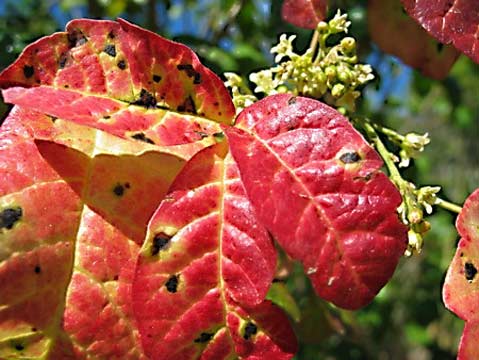Poisonous Plants
Create a Kid-Friendly Garden by Knowing Which Flora Is Harmful If Eaten

Poison oak (serious itching guaranteed), poison hemlock (remember Aristotle), stinging nettle—no one would consider putting these plants in their garden. But what about some of the lesser evils in the human/plant interface? Poinsettias, oleanders, tomato plants—everybody probably knows that these plants have a bad reputation. Common knowledge says that they are pure poison if ingested. And, with a few caveats, it is true. Poinsettias have toxic sap, but it would take eating nearly the whole plant to cause severe consequences. Oleanders contain a toxin that interrupts heart function, but roasting a frank on an oleander twig will probably not kill a boy scout, urban legend to the contrary.
Tomato plants and all of their relatives are also reputed to be poisonous, but they are also quite bitter, and it would take a person without any taste buds to eat much of one. The exception might be that the legend of datura (also known as jimson weed) is tempting enough for some young person searching for a mental trip to try it; a few have managed to eat or smoke enough to do damage to themselves. The point is that knowing a little bit about these plants can help allay fears and knowing a little more can help any gardener make educated choices about what to include in, or exclude from, their landscape.
Children like to put things in their mouths. “Don’t put that in your mouth!” is one of the most important lessons that parents enforce from infancy. Parenting gurus who advocate for only using positive reinforcements (“Walk” instead of “Don’t run”) have to give way on the issue of imminent danger. A toddler chewing on leaves from the garden needs to have that material firmly and gently, but thoroughly, removed from their hands and mouth. Hopefully, it will be evident what the plant in question is, and then the educated parent can remain in control of their own emotions, while educating their kids, as well. With that in mind, what should a kid-friendly garden contain? Or not?
No oleanders, right? Well, it is a very useful and handsome shrub, so consider making them inaccessible to toddlers, but instruct kids on their dangers (they won’t taste good anyway: lesson number one). Tomatoes, potatoes, Brugmansia (angel trumpet), Nicotiana (ornamental tobacco), and other solanums need not be permanently excluded, just used in appropriate situations. Poinsettias just don’t look all that edible, but the above rules apply. Most of their succulent euphorbia relatives also have some kind of spiny covering, so no big worries there.
What else should a person look out for? Foxglove (Digitalis species) is the original source of digitalis, the heart-stimulant drug. In sufficient doses, the leaves and flowers of this garden favorite could be extremely harmful to children who chew on them. Delphinium (sometimes called larkspur) can cause digestive upset and affect the nervous system; monkshood (Aconitum) can do the same, but only if the roots are ingested. Other roots and bulbs such as iris, daffodil, and hyacinth may also cause distress and damage, so don’t leave them lying around for curious youngsters.
Berries and seeds may be a bit more tempting to kids. They look like some of the foods that are safe and nutritious, so it is natural to give them a try. Common garden plants that have dangerous fruits are Daphne, wisteria, lantana, and jasmine. Less common in Southern California, but just as deadly, are golden chain (Laburnum) and yew.
Armed with knowledge about poisonous plants, the parent/gardener can decide what to grow. Passing that knowledge along to the next generation of gardeners is also a way to minimize accidental poisoning. And keep the poison control center phone number handy, too. It is (800) 222-1222.
June Tips
• Start seed for your giant pumpkin this month. Next month, pick one fruit to concentrate the plant’s energies, pinching out any others.
• Cover early fruiting shrubs and trees with bird netting to save the crop for your family.
• June gloom? Watch closely for powdery mildew. Wash spores off foliage early in the day or add 1½ tablespoons vegetable oil, 1½ teaspoons baking soda, 1 tablespoon vinegar, and 1 tablespoon dishwashing detergent to 1 gallon water and spray leaves well.
• Control mosquitoes with fish in ponds, or Bt (Bacillus thuringiensis) “dunks” in smaller container water gardens.



